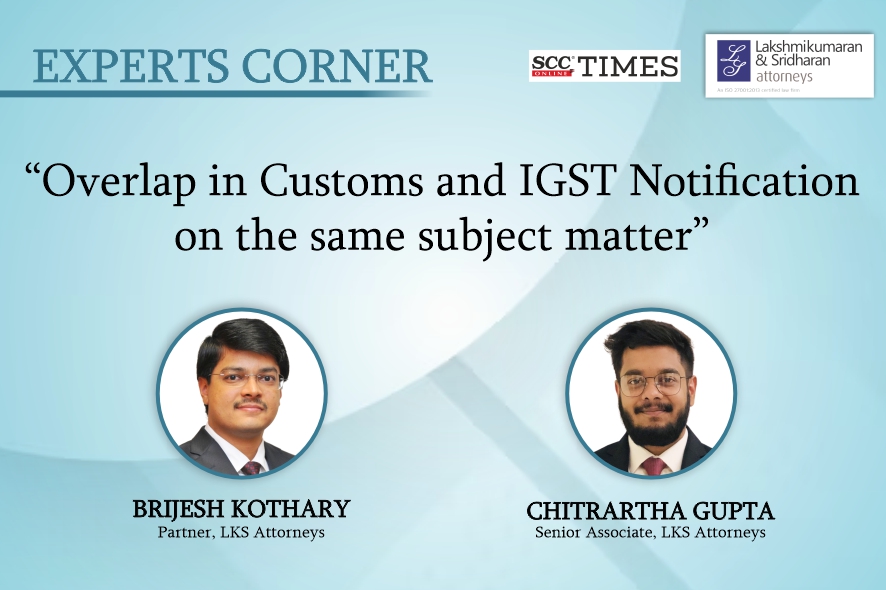Levy of integrated goods and services tax (IGST) as duty of Customs in terms of Section 3(7) of the Customs Tariff Act, 1975, is still a subject-matter pending before the judicial forums. In Interglobe Aviation Ltd. v. Commr. of Customs1, the Delhi Tribunal had observed that IGST collected at time of import is not levied under the Customs Act, 1962 or Customs Tariff Act. It was held that IGST is levied under Section 5(1) of the Integrated Goods and Services Tax Act, 2017 and only the procedure for collection has been provided under Section 3 of the Customs Tariff Act. The case is, however, pending before the Supreme Court.
Be that as it may be, every now and then new issues keep on raking up on this issue. Recently, the Customs Authorities have started issuing show-cause notices to importers who claimed exemption from payment of IGST under Notification2. It is Department’s contention that by virtue of Explanation 2 inserted in Notification No. 47/2017-Integrated Tax (Rate) dated 14-11-2017, IGST was leviable on import of goods (claiming Notification No. 51/1996-Customs) w.e.f. 15-11-2017 at the rate of 5%. Based on the above a demand of differential IGST along with interest and penalty is being made.
Understanding the notifications involved
Originally, Notification No. 51/1996-Customs, provided for Basic Customs Duty (‘BCD’) and IGST exemption on import of scientific and technical instruments, apparatus, accessories, and consumables, etc., by public funded research institute or a university, Central or State Government Department or Laboratory, etc., subject to fulfilment of certain conditions as prescribed in the said notification. The said notification was amended vide Notification No. 42/2022-Customs dated 13-7-2022, wherein the grant of exemption from payment of IGST was omitted w.e.f. 18-7-2022.
Notification No. 47/2017-Integrated Tax (Rate) (w.e.f. 15-11-2017), was also in operation wherein IGST was leviable at the rate of 5% on supply of similar goods to the aforementioned institutions. The following Explanation inserted vide Notification No. 10/2018-Integrated Tax (Rate)dated 25-1-2018:
Explanation 2.—For the purposes of this notification, exemption would be in line with the notification of the Government of India, in the Ministry of Finance (Department of Revenue), No. 51/96-Customs dated 23-7-1996, published in the was Gazette of India, Extraordinary, Part II, Section 3 sub-section (i), vide number G.S.R. 303(E) dated 23-7-1996 and is applicable with effect from 15-11-2017.
Reasons behind insertion of Explanation 2 in Notification No. 47/2017-Integrated Tax (Rate)
The Department seems to have interpreted the phrase “exemption would be in line with the notification” to mean that IGST @ 5% was applicable retrospectively from 15-11-2017, even for the imports wherein benefit of Notification No. 51/1996-Customs was being claimed towards both BCD and IGST.
The above amendments to the IGST Notification were made pursuant to justification listed in the 23rd GST Council Meeting dated 10-11-2017. The relevant extract of the justification3 for changes in IGST rates is as follows:
…
(d) While domestic goods are liable to GST.
(e) This puts domestic manufacturers in a disadvantageous position.
(f) 5% GST will to some extent restore level playing field for domestic manufacturers.
(g) Full exemption from GST will not be advisable, as it will break the input tax credit chain and add to cost of domestic manufacturers.
(h) The above 5% concessional GST rate would be subject to conditions as per existing Notification No. 51/96-Customs.
The above justifications, clarifies that concessional rate of 5% IGST was introduced to bring uniformity for both domestic manufacturers as well as importers dealing in scientific and technical instruments, etc. It also becomes clear that this 5% concessional rate for domestic players was subject to the conditions as existing in the Customs notification. In other words, it appears that vide Explanation 2, the IGST notification was only borrowing the specific compliance conditions for domestic manufacturers claiming 5% and not introducing a retrospective levy of IGST for imports.
In any case, from the importer’s perspective, it can be argued that at the time of imports since two notifications levying IGST were in existence (one offering complete exemption and the other offering 5% concessional rate), the importer has right to choose the notification which is more beneficial to him.4
On the other hand, the Department may dispute the above interpretation and may take shelter of Commr. of Cutoms (Import) v. Dilip Kumar & Co.5 to argue that benefit of ambiguity in an exemption notification cannot be claimed by the taxpayer and it must be interpreted in favour of the Department.
The importers who already have been issued with the show-cause notices may have to contest the same through adjudication route as provided in the Customs Act, 1962. Since the issue appears to be purely of interpretational nature, invocation of extended period under Section 28(4) of the Customs Act and penalty, if any, can be contested as well.
In our view, considering the availability of two benefits to the assesses importing goods for such research purposes, it will be advisable to approach the Board (Central Board of Indirect Taxes and Customs) through industry associations for an appropriate clarification on the admissibility of benefit of Notification No. 51/1996-Customs, for IGST till the amendment in 18-7-2022.
Though, the above issue is restricted to a specific issue/notification, but as a key takeaway, industries should proactively seek clarifications from the Board wherever there is an ambiguity with respect to the exemption notification. Such steps would help in saving precious time and resources of all the stakeholders spent in avoidable litigation.
* Partner., Lakshmikumaran & Sridharan Attorneys
** Senior Associate, Lakshmikumaran & Sridharan Attorneys
1. 2020 SCC OnLine CESTAT 268.
2. Notification No. 51/1996-Customs dated 23-7-1996 , available at: <http://www.scconline.com/DocumentLink/9m8M1R92>
3. Agenda for 23rd GST Council Meeting dated 10-11-2017 available at <https://gstcouncil.gov.in/sites/default/files/Agenda/23-meeting/Detailed%20Agenda.pdf>.
4. Share Medical Care v. Union of India, (2007) 4 SCC 573.







